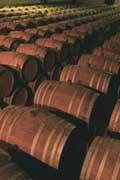French chemists analyse how the toasting of oak staves used to make wine barrels affects the chemical composition of the wood and the final uncorked product

The choice of oak barrel in which a wine will be matured has a profound effect on the bouquet, flavour, and colour of the final uncorked product. How and to what extent a cooper toasts the oak staves prior to making a barrel will in turn influence the qualities of the barrel. However, there is a small risk of toxic and potentially carcinogenic polyaromatic hydrocarbons (PAHs) and dioxins being formed during the toasting process. These might ultimately leach into the wine.
Now, Pascal Chatonnet and Julien Escobessa from Laboratoires Excell, Mérignac, France, have analysed the change in chemical composition of oak staves used to make barrels at various stages of the toasting process.1 Using GC-MS to identify and quantify chemicals produced in the wood, the team found that provided oak toasting takes place at the traditional 200ºC PAHs and dioxins are not formed at hazardous levels, leaving wine as safe a beverage as ever it was.
References
- P. Chatonnet and J. Escobessa, J. Agric. Food Chem., 2007, 55 (25), 10351






No comments yet